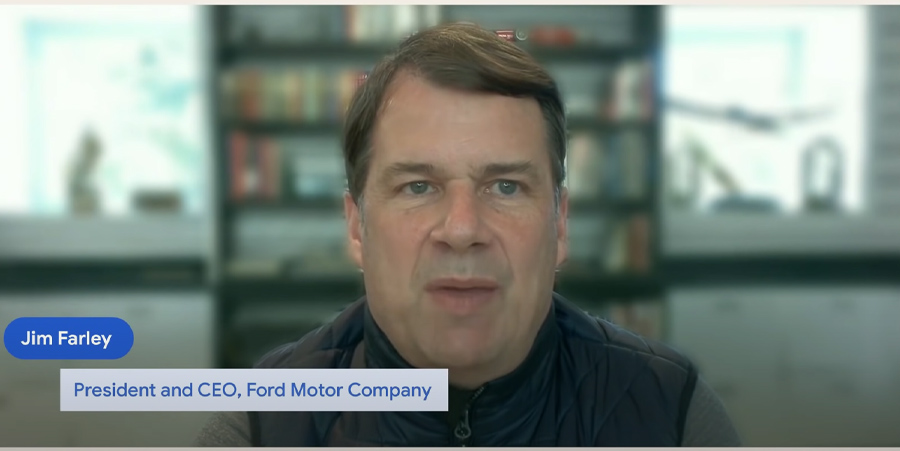In doing so, Ford is providing a blueprint for the future
Pre-pandemic, automakers were already facing massive disruption, including driverless cars, electric vehicles, and shared mobility. But COVID-19 dealt another blow: automotive was one of the hardest-hit sectors in 2020, especially in the U.S., where auto sales sank by 15 percent.
In the midst of these unprecedented challenges, however, 118-year-old Ford Motor Company leaned in and began to reinvent itself.
As the virus accelerated, dealerships were forced to close their lots and shift to servicing and selling cars online, while larger supply chain concerns caused shortages in critical parts like microchips, which slowed vehicle production.
In the midst of these unprecedented challenges, however, 118-year-old Ford Motor Company leaned in and began to reinvent itself. Under the leadership of two new executives—Jim Farley as CEO and Suzy Deering as CMO—the company saw an opportunity for business transformation and started mapping out a strategy.
Questioning everything from its organizational silos to its customer experience, Ford made difficult decisions to put technology at the center of its business and get ahead of auto consumers’ evolving needs.
While still in the early stages of its journey, Ford has developed something of a blueprint for auto brands of the future. Recently, I spoke to Farley and Deering about the company’s transformation. They shared three key changes they’re focused on.
1. REIMAGINING WHAT AUTO BRANDS DO
The notion of business transformation has been a buzzword for decades, but for years, it wasn’t an urgent reality for Ford. Following the Great Recession, the company was profitable. Then along came the pandemic, and its significance accelerated.JIM FARLEY, CEO OF FORD MOTOR COMPANY
“Events of 2020 made it clear that modernization is required to be a sustainable company,” explains Farley. A critical factor to modernizing has been disrupting its organizational model to aid the shift toward vehicle electrification and other digitally connected products. Since consumers expect more safety and convenience from automakers, the future of the auto industry will increasingly exist outside the doors of the vehicle.
According to Farley, this has required Ford to “unglue” its organization to allow for a new way of being. “The biggest transformation for us is to a software services-dominated company and brand,” he explains. “We have to invest in electric architectures and build software know-how in the company. And we need to integrate that know-how in ways we’ve never had to before.”
Such a fundamental pivot, Suzy Deering acknowledges, impacts company culture. “We have to make sure that we bring people along with us, and at the same time, give them the space to fail. There is strength in knowing that change is not going to be easy, but we’re going to do it together, and we’re going to look forward.”
2. DRIVING THE CONNECTED CAR EXPERIENCE FORWARD
By committing to look forward, the automaker is building on Henry Ford’s original vision – that every American consumer can own a vehicle – by reimagining what vehicle ownership looks like. Through software and other technology, Ford is working to ensure that it’s a fully connected, always-on experience.
“For so long, cars have really been isolated from the rest of people’s lives. We can change that by making them digital products,” Farley explains. To facilitate this shift, Ford has tapped into strategic partners like Google and is integrating software into its vehicles. Beginning in 2023, for example, millions of Ford and Lincoln models will be powered by the Android operating system, with Google apps and services built in.JIM FARLEY, CEO OF FORD MOTOR COMPANY
Beyond offering drivers more assistance and convenience, connected vehicles also give Ford the ability to deepen its customer relationships. “When we have the ability to update our products dynamically with software, the customer relationship is no longer episodic. It’s every day,” says Farley.
3. TRANSFORMING THE CUSTOMER RELATIONSHIP MODEL
To deliver on its vision of an always-on customer experience, Ford is also evolving how it approaches relationship-building. While many automakers stick to a traditional acquisition model to attract consumers through ads and rebates, Ford is bringing customer relationships to the forefront by shifting to a loyalty-based model.
“Another big transition for us as a company—and an industry—is to stop being obsessed with conquest, and start putting all our resources into taking care of the customers who already love the brand and own the product,” Farley explains. “This is a model that is available because of the always-on nature of digital. Our products and services are now integrated.”
We want to know our customers well enough to meet their needs while they’re in the vehicle, while they’re outside the vehicle, and before they even think about buying a vehicle
Gearing marketing efforts to meet people’s ongoing needs in a more personalized way is critical to Ford’s loyalty-based push, because, as Deering points out, “The customer expects us to know them.”
For Deering and her team, this means relying more than ever on first-party data and signals to create an ecosystem that nurtures deeper relationships. “We want to know our customers well enough to meet their needs while they’re in the vehicle, while they’re outside the vehicle, and before they even think about buying a vehicle from us,” she explains.
While Deering and Farley both readily admit that Ford’s business transformation is a years-long journey, they’re committed to playing the long game and continuing to drive brand love and loyalty through the twenty-first century.
…
This article first appeared in www.fastcompany.com
Seeking to build and grow your brand using the force of consumer insight, strategic foresight, creative disruption and technology prowess? Talk to us at +971 50 6254340 or mail: engage@groupisd.com or visit www.groupisd.com/story




